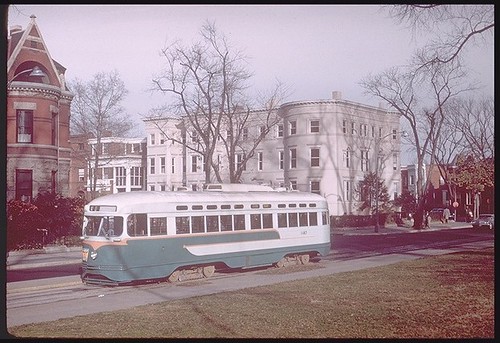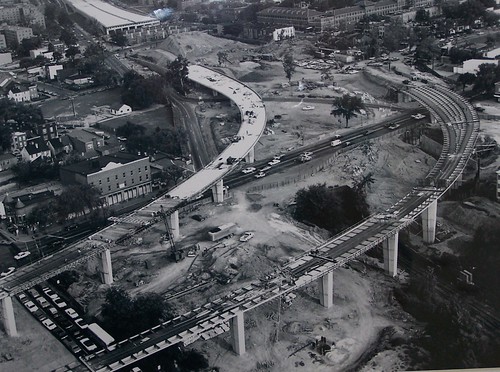Why I favor streetcars

Three streetcars built in the Czech Republic arrived by ship in Baltimore last weekend. The wormlike vehicles are flexible in places and so can negotiate turns better than their older counterparts. Photo Credit: DC Department Of Transportation
In a side e-conversation that derived from an e-conversation thread on a Tenleytown area e-list, I have come to realize that the big problem with the discussion about streetcars is that people are talking past each other. I look at this in terms of broad questions about the future competitiveness of the city and substantive increases in traffic while others think about this as a streetcar line vs. a particular bus line. This email is part of a broader chain, and is edited slightly to add context...
1. Obstructions aren't the end of the world. They are dealt with. FEMS policies could deal with more focused street closures (they are pretty overbroad now). Etc.
You just can't completely discount a technology and make a policy based on a once in a year or a decade occurrence [of an obstruction in the way of a streetcar that because it is rail-based, can't move around it, unlike a bus].
Frankly, to use the same standard--which you seem to think is appropriate for streetcars, to be fair, you'd have to close the freeways during rush hours, because typically there is a catastrophic occurrence (accident) resulting in significant travel delays at least once/month, if not more frequently, and tie ups at specific choke points every day during rush periods (i.e., merging from one freeway to another, such as from 270 to 495 or 495 to 95, or from the HOV lanes in Fairfax to the regular lanes once the HOV lanes end, or 695 to 83 in Baltimore County--I work in Baltimore County).
2. But of course, the reason you have separated heavy rail systems, including underground construction and service, is to be able to provide (relatively) unimpeded service. Yes, street-based in-traffic rail service will never be as fast as separated and underground service.
3. I think it's a reasonable tradeoff, since it's not unlikely that over time ridership on streetcars could double compared to bus service, removing significant amounts of vehicular traffic from the system, which will have extranormally positive benefits for residents and other users of the transportation system within the city.
4. I was thinking about the previous email after I sent it, and for most of the buses that I ride regularly (and I do not ride the 30s buses that often, or the buses on CT Ave., but I have extensive experience with the 50s, 60s, 70s, 90s, G8, X , H, S, and certain D bus lines in DC, and the 8 and 48 in Baltimore) typically fewer than 10% of the total ridership is white. (The wee bit of RideOn service I've experienced has more white riders.)
Since more than 30% of the population of the respective cities is white (and it happens that the demographics of this population in those places demonstrates that these people tend to be of significantly higher income compared to the Black and Hispanic populations, and especially those populations that typically ride buses), it is fair to say that this potential market segment has demonstrated for decades it is unwilling to ride typical bus service.
5. Of course, streetcar ridership dropped because of the widespread adoption of the personally owned vehicle as a mobility technology generally, and as the primary mobility technology specifically.
This was compounded and at the same time automobile use complemented suburban outmigration and the shrinking of center cities. (Actually, in many places streetcar usage started dropping before the Depression, because of outmigration and the spead of suburban development and the adoption of the automobile. It rose during the WWII period when employment rose and automobile production ceased in favor of war production.)

PCC streetcar on Lincoln Park, source and date unknown.
However, into the early 1960s, transit utilization in certain center cities, such as Washington, was still high. It's likely, although you can never answer this question definitively, that the change in technology from streetcar to bus was a significant factor in the subsequent drop.

SE-SW Freeway under construction near the Marine Barracks, 1971. DDOT photo.
6. Bus ridership decreased with the Metrorail but that is not what I am talking about. Transit utilization dropped significantly during the period that streetcars were being discontinued, and especially after the service ceased in DC in 1962. This preceded shifting from bus to subway once the Metrorail system opened and continued to expand. (Not to mention expansions in ridership associated with further system expansion as the realization of the original plan was achieved.)
At the same time, bus ridership stabilized and "increased" with the operation of Metrorail, because of its complementary aspect to heavy rail in providing riders with a complete trip from origination to final destination.
7. Because of the likely significant increase in ridership from streetcars [compared to buses], because of the fact that DC specifically is a "transit city," given that today 50% of daily work trips are made via walking, bicycling, and transit, because of the city's competitive advantages deriving from streetcars, because of the real fact that there is "lack of inventory" that the street network is virtually fully built out, the ability to significantly improve access and mobility by adding streetcars to the transit system, and the significant decrease over time that is likely to result in traffic on DC streets (traffic that is generated in the region as well as within the city specifically), the cost difference between bus vehicles and streetcar vehicles is almost immaterial.
8. It isn't immaterial, but you and I are interpreting and answering the question completely differently.
You look at this question in terms of the 30s bus.
I think of this in terms of my broad concepts of the metropolitan transit network, the DC transit network, the transit shed, the mobility shed (all my concepts, extended of course, from ideas of others--come to my presentation about these concepts in March at the U of Delaware if you want...) combined with a rigorous transportation demand management protocol, and the competitive advantage of the city and its locational value in terms of a place to live and a place to locate business and as a place to conduct commerce, go to school, visit, and play, and improvements in the overall quality of life within the city.
So one is about a bus line. The other is about how to increase the economic, social, cultural, and transportational value of the city, how to ensure that the ROI from transit is constantly increasing and substantial, rather than neutral and/or declining and failing to keep pace with developments outside of the city, in the metropolitan area, in jurisdictions that compete with the city for residents, jobs, and activity centers.
Transit expansion and substantive improvements in the quality of the service that is provided on-street (as well as the separated and/or underground subway service) will allow the city to maintain its relevance and value in the context of the landscape of the metropolitan and regional and national economy.
I am looking at this as a 50+ year time frame and investment in the city.
You need to consider the question similarly.
As long as we are talking past each other, we will never have consensus.

Streetcar rail installed on Benning Road, for the future streetcar line. Photo by Matt Johnson.
Labels: car culture and automobility, streetcars, transit and economic development, transportation planning



0 Comments:
Post a Comment
<< Home